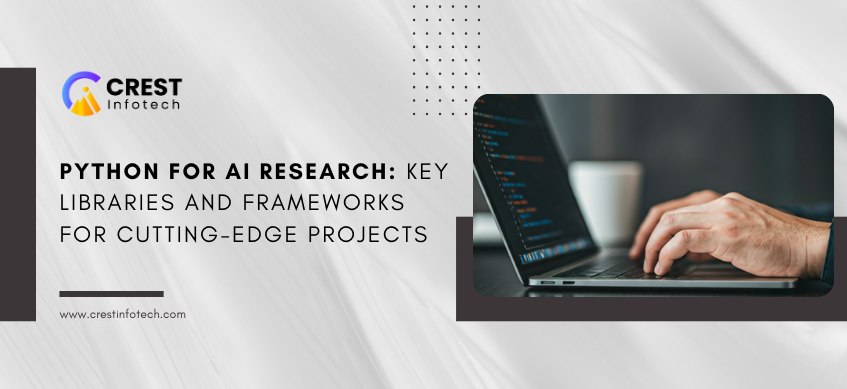Artificial Intelligence (AI) has revolutionized numerous industries, from healthcare and finance to entertainment and autonomous systems. At the heart of this revolution lies Python, a versatile and powerful programming language favored by researchers and developers alike. Python’s simplicity, combined with its extensive ecosystem of libraries and frameworks, makes it an indispensable tool for AI research and development. This article explores the key libraries and frameworks that empower cutting-edge AI projects.
1. NumPy and SciPy: Foundations of Numerical Computation
NumPy and SciPy are foundational libraries for numerical and scientific computing in Python. NumPy provides support for high-performance multidimensional arrays and matrices, while SciPy extends NumPy’s functionality with modules for optimization, integration, and statistical analysis. These libraries are essential for preprocessing data and implementing basic mathematical operations that underpin AI algorithms.
2. Pandas: Data Manipulation Made Easy
AI projects often involve processing vast amounts of structured data. Pandas simplifies data manipulation with its intuitive DataFrame structure, enabling researchers to clean, transform, and analyze datasets efficiently. Its integration with other libraries ensures seamless workflows, making it a go-to tool for data preprocessing in AI pipelines.
3. Scikit-learn: The Swiss Army Knife for Machine Learning
Scikit-learn is a comprehensive library for traditional machine learning algorithms, including classification, regression, clustering, and dimensionality reduction. Its user-friendly API and extensive documentation make it ideal for building and evaluating models quickly. Scikit-learn also provides tools for model selection and validation, ensuring robust and reliable results.
4. TensorFlow and PyTorch: Deep Learning Titans
Deep learning has transformed AI research, and TensorFlow and PyTorch are the leading frameworks for building neural networks.
- TensorFlow: Developed by Google, TensorFlow is a highly flexible framework for designing, training, and deploying deep learning models. Its ecosystem includes TensorFlow Hub for pre-trained models and TensorFlow Lite for mobile and edge deployment.
- PyTorch: Known for its dynamic computation graph and ease of use, PyTorch has gained immense popularity among researchers. PyTorch’s flexibility makes it ideal for experimenting with novel architectures and algorithms, while its TorchServe extension supports scalable model deployment.
5. Keras: Simplifying Deep Learning
Built on top of TensorFlow, Keras offers a high-level API for constructing and training neural networks. Its straightforward syntax allows researchers to prototype models quickly, making it perfect for beginners and those focusing on rapid experimentation.
6. OpenCV: Computer Vision Simplified
OpenCV is a powerful library for computer vision tasks, such as image and video processing. Its wide range of functionalities includes object detection, face recognition, and motion analysis. OpenCV integrates well with deep learning frameworks, enabling researchers to combine traditional computer vision techniques with advanced neural networks.
7. Natural Language Toolkit (NLTK) and spaCy: Text Processing Tools
Text data is central to many AI applications, including chatbots, sentiment analysis, and machine translation.
- NLTK: A comprehensive library for natural language processing (NLP), NLTK provides tools for tokenization, stemming, and syntactic parsing. It’s ideal for learning and prototyping.
- spaCy: Designed for production, spaCy offers state-of-the-art models for tasks like named entity recognition (NER) and part-of-speech tagging. Its efficiency and ease of use make it a favorite for deploying NLP systems.
8. Hugging Face Transformers: State-of-the-Art NLP
Hugging Face has revolutionized NLP with its Transformers library, which provides pre-trained models like BERT, GPT, and T5. These models excel in tasks such as text classification, summarization, and question answering. The library’s user-friendly interface and active community support rapid experimentation and deployment of advanced NLP systems.
9. Matplotlib and Seaborn: Visualizing Insights
Effective visualization is crucial for interpreting AI models and their results. Matplotlib and Seaborn offer powerful tools for creating static, interactive, and animated plots. Seaborn’s high-level interface simplifies the creation of complex visualizations, making it an invaluable asset for data analysis and presentation.
10. Dask and Apache Spark: Scaling AI with Big Data
As datasets grow in size and complexity, scalable solutions become essential.
- Dask: A Python-native library, Dask enables parallel computing on large datasets using familiar Pandas and NumPy syntax.
- Apache Spark: Renowned for its speed and scalability, Spark supports distributed computing for massive datasets, making it a key player in big data AI projects.
11. FastAPI and Flask: Deploying AI Models
Deploying AI models requires robust and efficient APIs. FastAPI and Flask are popular frameworks for building web applications and APIs. FastAPI’s speed and built-in validation tools make it ideal for serving machine learning models in production environments.
Conclusion
Python’s extensive ecosystem of libraries and frameworks provides the tools necessary for every stage of AI research and development, from data preprocessing and model building to deployment and scaling. Whether you are a beginner exploring AI or a seasoned researcher pushing the boundaries of innovation, Python equips you with the resources to turn ideas into reality. By leveraging these key libraries and frameworks, you can embark on a journey to create impactful AI solutions for the challenges of today and tomorrow.



